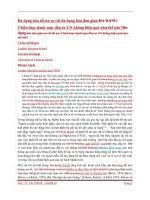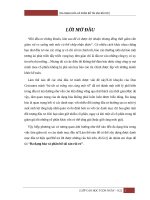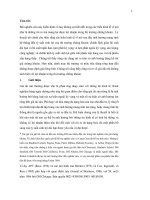Tiểu luận môn đầu tư tài chính THE ROLE OF EXPECTATIONS IN MONEYTARY POLICY
Bạn đang xem bản rút gọn của tài liệu. Xem và tải ngay bản đầy đủ của tài liệu tại đây (3.81 MB, 109 trang )
CHAPTER 25
THE ROLE OF EXPECTATIONS IN
MONEYTARY POLICY
GVHD: GS.TS Trần Ngọc Thơ
Người thực hiện:
Bùi Thị Như Ý
Nguyễn Thị Mỹ Vân
8/1/17
1
ASSIGNMENTS
Name of members
Assignments
•
Translate and prepare slides for part I (Lucas critique of Policy
evaluation) and part II (Policy conduct: Rules or Discretion?).
Bùi Thị Như Ý
•
Translate and prepare slides for part III (The Role of Credibility and
A Nominal Anchor) and Part IV (Approaches to Establishing Central
Bank Credibility)
•
Prepare Extention part.
Nguyễn Thị Mỹ Vân
8/1/17
2
PREVIEW
Reason
•
Discretionary policies could reduce the severity of business cycle fluctuations without
creating inflation.
•
In the 1960s and 1970s, these economists got their chance to put discretionary policies
into practice, but the results were not what they had anticipated. The economic record
for that period is not a happy one: Inflation accelerated, the rate often climbing above
10%, while unemployment figures deteriorated from those of the 1950s.
PREVIEW
Robert Lucas and Thomas Sargent used the rational expectations theory discussed in Chapter 7 to examine
why discretionary policies appear to have performed so poorly.
Their analysis cast doubt:
- On whether macroeconomic models can be used to evaluate the potential effects of policy.
- On whether policy can be effective when the public expects that it will be implemented.
GOALS OF CHAPTER
Examines the analysis behind the rational expectations revolution of the Lucas
critique.
Discuss the effect of rational expectations on the aggregate demand and supply
analysis
Explore how this theoretical breakthrough has shaped current policy-making models and
debates.
8/1/17
5
CONTENTS
THE
THE ROLE
ROLE OF
OF EXPECTATION
EXPECTATION IN
IN MONETARY
MONETARY POLICY
POLICY
Lucas
Lucas Critique
Critique Of
Of Policy
Policy Evaluation
Evaluation
Econometric
Econometric Policy
Policy Evaluation
Evaluation
Application:
Application: The
The Term
Term Structure
Structure Of
Of
Interest
Interest Rates
Rates
Policy
Policy Conduct:
Conduct: Rules
Rules Or
Or Discretion?
Discretion?
Discretion
Discretion And
And The
The Time-Inconsistency
Time-Inconsistency
Problem
Problem
Types
Types Of
Of Rules
Rules
The
The Role
Role Of
Of Credibility
Credibility And
And A
A Noninal
Noninal anchor
anchor
Approaches
Approaches To
To Establishing
Establishing Central
Central
Bank
Bank Credibility
Credibility
Benefits
Benefits Of
Of A
A Credible
Credible Nominal
Nominal Anchor
Anchor
Appoint
Appoint “Conservative”
“Conservative” Central
Central Bankers.
Bankers.
Credibility
Credibility And
And Aggregate
Aggregate Demand
Demand Shocks
Shocks
Inside
Inside the
the Fed:
Fed: The
The Appointment
Appointment of
of Paul
Paul
Volcker,
Volcker, Anti-Inflation
Anti-Inflation Hawk
Hawk
The
The Case
Case For
For Rules.
Rules.
Credibility
Credibility And
And Aggregate
Aggregate Supply
Supply Shocks
Shocks
FYI:
FYI: The
The Political
Political Business
Business Cycle
Cycle and
and
Application:
Application: A
A Tale
Tale Of
Of Three
Three Oil
Oil Price
Price
Richard
Richard Nixon
Nixon
Shocks
Shocks
The
The Case
Case For
For Discretion
Discretion
Constrained
Constrained Discretion.
Discretion.
Global:
Global: The
The Demise
Demise of
of Monetary
Monetary
Targeting
Targeting in
in Switzerland
Switzerland
Credibility
Credibility And
And Anti-Inflation
Anti-Inflation Policy.
Policy.
Global:
Global: Ending
Ending the
the Bolivian
Bolivian Hyperinflation:
Hyperinflation: A
A
Successful
Successful Anti-Inflation
Anti-Inflation Program
Program
Application:
Application: Credibility
Credibility And
And The
The Reagan
Reagan
Budget
Budget Deficits
Deficits
Lucas Critique Of Policy Evaluation
Economists have long used macroeconometric models to forecast economic activity and to evaluate the
potential effects of policy options. In essence, the models are collections of equations that describe statistical
relationships among many economic variables. Economists can feed data into such models, which then
churn out a forecast or prediction
Econometric Policy Evaluation: A Critique, Robert Lucas spurred the rational expectations revolution
by presenting a devastating argument against the use of macroeconometric models used at the time for
evaluating policy
Lucas Critique Of Policy Evaluation
Rational expectations theory
The rational expectations theory is an economic idea that the people make choices based on their
rational outlook, available information and past experiences. The theory suggests that the current
expectations in the economy are equivalent to what people think the future state of the economy will
become. This contrasts with the idea that government policy influences people's decisions.
Adaptive Expectations
Rational Expectations
Lucas Critique Of Policy Evaluation
Rational expectations theory
Adaptive Expectations
•
•
Expectations of inflation, for example, were typically viewed as
Rational Expectations
•
Adaptive expectations have been faulted on the grounds that
being an average of past inflation rates. This view of expectation
people use more information than just past data on a single
formation, called adaptive expectations, suggests that changes in
variable to form their expectations of that variable. Their
expectations will occur slowly over time as past data change.
expectations of inflation will almost surely be affected by their
So if inflation had formerly been steady at a 5% rate, expectations
predictions of future monetary policy as well as by current and past
of future inflation would be 5%, too. If inflation rose to a steady rate
monetary policy.
of 10%, expectations of future inflation would rise toward 10%, but
•
In addition, people often change their expectations quickly in the
slowly: In the first year, expected inflation might rise only to 6%; in
light of new information. To meet these objections to adaptive
the second year, to 7%; and so on.
expectations, John Muth developed an alternative theory of
expectations, called rational expectations, which can be stated as
follows: Expectations will be identical to optimal forecasts (the best
guess of the future) using all available information
Lucas Critique Of Policy Evaluation
Rational expectations theory
To explain it more clearly, let’s use the theory of rational expectations to examine how
expectations are formed in a situation that most of us encounter at some point in our lifetime: our drive
to work. Suppose that if Joe Commuter travels when it is not rush hour, it takes an average of 30
minutes for his trip. Sometimes it takes him 35 minutes, other times 25 minutes, but the average non–
rush-hour driving time is 30 minutes. If, however, Joe leaves for work during the rush hour, it takes
him, on average, an additional 10 minutes to get to work. Given that he leaves for work during the
rush hour, the best guess of the driving time—the optimal forecast—is 40 minutes.
Rational expectations theory
An expectation may fail to be rational for two reasons:
People might be aware of all available information but find it takes too much effort to make
their expectation the best guess possible.
People might be unaware of some available relevant information, so their best guess of the
future will not be accurate.
Lucas Critique Of Policy Evaluation
Econometric Policy Evaluation
To understand Lucas’s argument, we must first understand how econometric policy evaluation is done. For
example, that the Federal Reserve wants to evaluate the potential effects of changes in the federal funds
rate from the existing level of 5%.
Using conventional methods, the Fed economists would feed different fed funds rate options—say, 4%
and 6%—into a computer version of the model. The model would then predict how unemployment and
inflation would change under the different scenarios. Then, the policymakers would select the policy
with the most desirable outcomes.
When policies change, public expectations will shift as well. For example, if the Fed raises the federal
funds rate to 6%, this action might change the way the public forms expectations about where interest rates
will be in the future.
Lucas Critique Of Policy Evaluation
Econometric Policy Evaluation
Those changing expectations, as we’ve seen, can have a real effect on economic behavior and outcomes. Yet
econometric models that do not incorporate rational expectations ignore any effects of changing expectations,
and thus are unreliable for evaluating policy options.
The Lucas Critique Of Policy Evaluation
Application: The Term Structure of Interest Rates
The equation relates the long-term interest rate to current and past values of the short-term interest rate.
It is one of the most important equations in macroeconometric models because the long-term interest rate, not
the short-term rate, is the one believed to have the larger impact on aggregate demand.
In Chapter 6, we learned that the long-term interest rate is related to an average of expected future shortterm interest rates.
The Lucas Critique Of Policy Evaluation
Application: The Term Structure of Interest Rates
Suppose that in the past, when the short - term rate rose, it quickly fell back down again; that is, any
increase was temporary. Because rational expectations theory suggests that any rise in the short-term interest rate
is expected to be only temporary, a rise should have only a minimal effect on the average of expected future
short-term rates. It will cause the long-term interest rate to rise by a negligible amount. The term structure
relationship estimated using past data will then show only a weak effect on the long-term interest rate of changes
in the short-term rate.
The Lucas Critique Of Policy Evaluation
Application: The Term Structure of Interest Rates
Suppose the Fed wants to evaluate what will happen to the economy if it pursues a policy that is likely to raise the short-term
interest rate from a current level of 3% to a permanently higher level of 5%.
The term structure equation that has been estimated using past
If the public recognizes that the short-term rate is rising to a permanently
data will indicate that just a small change in the long-term
higher level, rational expectations theory indicates that people will no
interest rate will occur.
longer expect a rise in the short-term rate to be temporary. Instead, when
they see the interest rate rise to 5%, they will expect the average of future
short-term interest rates to rise substantially, and so the long-term
interest rate will rise greatly.
The Lucas Critique Of Policy Evaluation
Application: The Term Structure of Interest Rates
The term structure application demonstrates another aspect of the Lucas critique.
The effects of a particular policy depend critically on the public’s expectations about the policy. If the
public expects the rise in the short-term interest rate to be merely temporary, the response of long-term interest
rates, as we have seen, will be negligible.
If, however, the public expects the rise to be more permanent, the response of long-term rates will be far
greater
The Lucas critique points out not only that conventional econometric models cannot be used for policy
evaluation, but also that the public’s expectations about a policy will influence the response to that policy.
The Lucas Critique Of Policy Evaluation
Sumary: The Lucas Critique
The term structure equation discussed here is only one of many equations in econometric models to
which the Lucas critique applies. In fact, Lucas uses the examples of consumption and investment equations
in his paper.
It deals with expectations in a financial market, a sector of the economy for which the theory and
empirical evidence supporting rational expectations are much stronger.
The Lucas critique should also apply, however, to sectors of the economy for which rational
expectations theory is more controversial, because the basic principle of the Lucas critique is not that
expectations are always rational but rather that the formation of expectations changes when the behavior of
a forecasted variable changes.
Policy Conduct: Rules Or Discretion
Discretion and the time-Inconsistency problem
Policymakers operate with discretion when they make no commitment to future actions, but
instead make what they believe in that moment to be the right policy decision for the situation.
Empowering policymakers to shape policy on-the-fly introduces complexities.
Recall that the time-inconsistency problem is the tendency to deviate from good long-run plans
when making short-run decisions.
Policymakers are always tempted to pursue a policy that is more expansionary than firms or people
expect because such a policy would boost economic output (and lower unemployment) in the short run.
Policy Conduct: Rules Or Discretion
Discretion and the time-Inconsistency problem
The best policy, however, is not to pursue expansionary policy, because decisions about wages and prices
reflect workers’ and firms’ expectations about policy (an implication of the rational expectations revolution).
When workers and firms see a central bank, for example, pursuing discretionary expansionary policy, they
will recognize that this is likely to lead to higher inflation in the future. They will therefore raise their expectations
about inflation, driving wages and prices up. The rise in wages and prices will lead to higher inflation, but may
not result in higher output on average.
Policymakers will have better inflation performance in the long run if they do not try to surprise people with an
unexpectedly expansionary policy, but instead keep inflation under control. One way to do this is to abandon
discretion and adopt rules to govern policy making.
Policy Conduct: Rules Or Discretion
Types Of Rules
In contrast to discretion, rules are essentially automatic.
One famous type of rule, is the constant-money-growth-rate rule, in which the money supply is kept growing at a
constant rate regardless of the state of the economy.
Other monetarists have proposed variants of this rule that allow the rate of money supply growth to be adjusted for
shifts in velocity, which has often been found to be unstable in the short run.
Rules of this type are nonactivist because they do not react to economic activity. Monetarists advocate rules of this type
because they believe that money is the sole source of fluctuations in aggregate demand and because they believe that long and
variable lags in the effects of monetary policy will lead to greater volatility in economic activity and inflation if policy
actively responds to unemployment (as discussed in Chapter 23).
Policy Conduct: Rules Or Discretion
Types Of Rules
Activist rules, in contrast, specify that monetary policy should react to the level of output as well as to
inflation. The most famous rule of this type is the Taylor rule. It specifies that the Fed should set its federal
P
T
funds rate target by a formula that considers both the output gap (Y− Y ) and the inflation gap (π- π ).
Policy Conduct: Rules Or Discretion
The Case For Rules
As our discussion of the time-inconsistency problem suggests, discretionary monetary policy can lead
to poor economic outcomes.
If monetary policymakers operate with discretion, they will be tempted to pursue overly
expansionary monetary policies to boost employment in the short run but generate higher inflation (and no
higher employment) in the long run.
A commitment to a policy rule like the Taylor rule or the constant-money-growth-rate rule solves the
time-inconsistency problem because policymakers have to follow a set plan that does not allow them to
exercise discretion and try to exploit the short-run tradeoff between inflation and employment.
Policymakers can achieve desirable long-run outcomes.
Policy Conduct: Rules Or Discretion
The Case For Rules
Another argument for rules is that policymakers and politicians cannot be trusted.
Milton Friedman in A Monetary History of the United States, documents numerous instances in which
the Federal Reserve made serious policy errors, with the worst occurring during the Great Depression, when the
Fed just stood by and let the banking system and the economy collapse.
The politicians who make fiscal policy are also not to be trusted because they have strong incentives to
pursue policies that help them win the next election. They are therefore more likely to focus on increasing
employment in the short run without worrying that their actions might lead to higher inflation further down the
road. Their advocacy for expansionary policies can then lead to the so-called political business cycle, in which
fiscal and monetary policy is expansionary right before elections, with higher inflation following later.
Policy Conduct: Rules Or Discretion
FYI: The Political Business Cycle and Richard Nixon
Richard Nixon and his aides took some extraordinary actions to ensure a landslide victory in the
1972 presidential election.
The Nixon administration imposed wage and price controls on the economy, which temporarily
lowered the inflation rate before the election.
After the election, those same moves helped lead to a surge in inflation. Nixon also pursued
expansionary fiscal policy by cutting taxes.
The aftermath was ugly. The economy overheated and inflation rose to over 10% by the late
1970s, which was abetted by the negative supply shocks during that period (see Chapter 22).









